Alabanda is a Polish nobility coat of arms, used by several szlachta families in the times of the Kingdom of Poland.
Alabanda is a Polish nobility coat of arms, used by several szlachta families in the times of the Kingdom of Poland.
According to a legend the Alabanda coat of arms comes from the times of the Piast dynasty in the 12th century. It was first mentioned in records in 1278 [1] and no longer used after the 16th century. [2]
Escutcheon: Sable (or Azure) a horse head Argent issuant from a crescent of the same. Crest: Three (or five) ostrich feathers.
Notable bearers of this coat of arms include:

Nałęcz is a Polish coat of arms. It was used by associated szlachta families in the Kingdom of Poland and the Polish–Lithuanian Commonwealth (1569–1795).
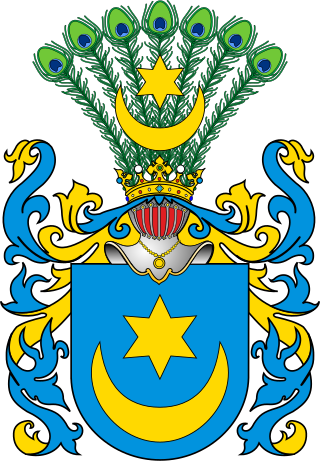
Leliwa is a Polish coat of arms. It was used by several hundred szlachta families during the existence of the Kingdom of Poland and the Polish–Lithuanian Commonwealth, and remains in use today by many of the descendants of these families. There are several forms of the arms, all of which bear the name, Leliwa, but which may be distinguished as variations of the same arms by the addition of a Roman numeral. In 19th century during a pan South-Slavic Illyrian movement heraldic term Leliwa also entered Croatian heraldry as a name for the coat of arms considered to be the oldest known symbol; Bleu celeste, a mullet of six points Or surmounted above a crescent Argent – A golden six-pointed star over a silver crescent moon on a blue shield, but also as a name for all other coats of arms that have a crescent and a mullet.
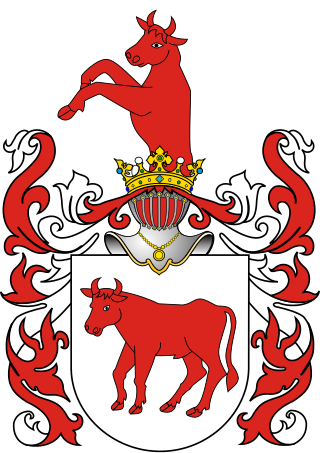
Ciołek is a Polish coat of arms, one of the oldest in medieval Poland. It was used by many szlachta (noble) families under the late Piast dynasty, under the Polish–Lithuanian Commonwealth, during the Partitions of Poland, and in the 20th century. The variant names "Siolek" and "Cialek" arose from miscommunication among early-20th-century Polish immigrants to the United States.
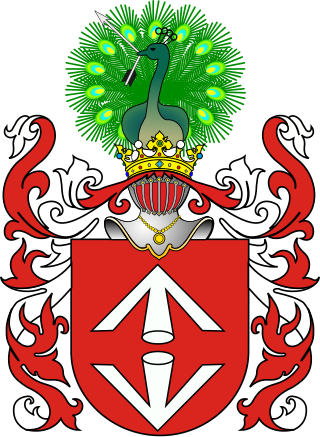
Bogoria is a Polish coat of arms. It was used by several szlachta families in medieval Poland and later under the Polish–Lithuanian Commonwealth, branches of the original medieval Bogoriowie family as well as families connected with the Clan by adoption.
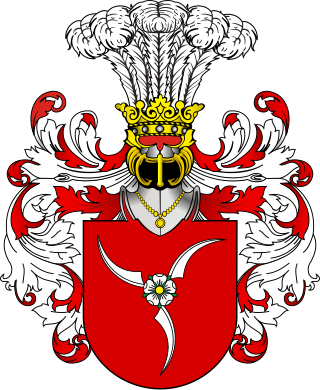
Rola is a Polish coat of arms. It was used by several szlachta families in the times of the Kingdom of Poland and Polish–Lithuanian Commonwealth.

Topór is a Polish coat of arms. It was used by several szlachta (noble) families in medieval Poland and under the Polish–Lithuanian Commonwealth.

Ogończyk is a Polish coat of arms. It was used by several szlachta families in the times of the Kingdom of Poland and the Polish–Lithuanian Commonwealth.

Korybut is a Polish coat of arms. It was used by the Princely House of Wiśniowiecki-Zbaraski and several branches of the House of Nieświcki in the times of the Polish–Lithuanian Commonwealth.

Polish heraldry is the study of the coats of arms that have historically been used in Poland and the Polish–Lithuanian Commonwealth. It treats of specifically Polish heraldic traits and of the Polish heraldic system, contrasted with heraldic systems used elsewhere, notably in Western Europe. Due to the distinctive ways in which feudal societies evolved. Poland's heraldic traditions differ substantially from those of the modern-day German lands and France.

Bojcza is a Polish coat of arms. It was used by several szlachta families.

Wieniawa is a Polish coat of arms. It was used by several noble, in Polish language szlachta families in the times of medieval Poland and the Polish–Lithuanian Commonwealth.

Hozyusz is a Polish coat of arms. It was used by several szlachta families.

Ostoja is a Polish coat of arms that probably originated from Sarmatian Tamga and refer to Royal Sarmatians using Draco standard. Following the end of the Roman Empire, in the Middle Ages it was used by Ostoja family in Lesser Poland and later also in Kujavia, Mazowsze and Greater Poland. It is a coat of arms of noble families that fought in the same military unit using battle cry Hostoja or Ostoja, and that applied their ancient heritage on the Coat of Arms, forming a Clan of knights. Later, when the Clan expanded their territory to Pomerania, Prussia, Slovakia, Hungary and Romania they also adopted a few noble families of Ruthenian origin that in 14-15th century settled down in Lithuania, Belarus and Ukraine, finally turning into the Clan of Ostoja. As different lines of the clan formed surnames after their properties and adding the adoptions, Ostoja was also recognized as CoA of several families that was not necessary connected to the original Clan, forming Heraldic clan.

Jeż is a Polish coat of arms.

Achinger is a Polish coat of arms. It was used by several szlachta families in the times of the Kingdom of Poland and the Polish–Lithuanian Commonwealth.

Alemani is a Polish nobility coat of arms originated from Italy.
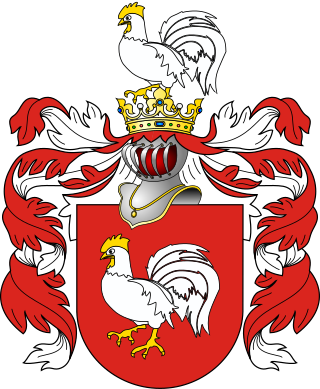
Kur is a Polish coat of arms. It was used by several noble families forming a Clan of Kur in the times of the Kingdom of Poland and the Polish–Lithuanian Commonwealth. It is noted during the reign of the Jagiellon dynasty and illustrated with its original name in the work of Bartosz Paprocki "Herby Rycerstwa Polskiego" in 1584. Furthermore, it is published in the work of Szymon Okolski in 1641. and several other publications

The Montelupi family ennoblement in Renaissance Poland took place on June 22, 1567 in Kraków, at the St. Mary's Basilica. Two brothers, Italian-born merchants Sebastian Montelupi and Karol (Carlo) received the Montelupi (Wilczogórski) Coat of arms (pictured). Its replica can be seen on the late 16th century tomb of Sebastian Montelupi at the Kraków Basilica. According to Polish historian Józef Szymański there's no proof confirming that the heraldic blazon is authentic.
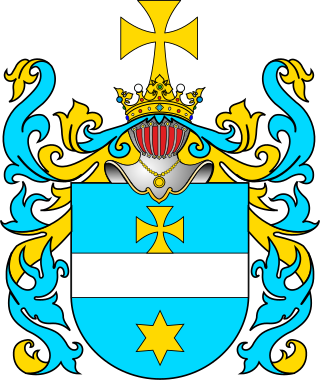
Krucina is a Polish coat of arms. It was used by the Korniakt family (szlachta) in the Polish–Lithuanian Commonwealth.

The Wielondek family is an old Polish nobility family, Nałęcz coat of arms, that first began to gather prominence during the second half of the 15th century.